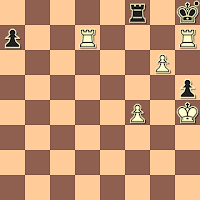If you stop and think about it, the Jerome Gambit (1.e4 e5 2.Nf3 Nc6 3.Bc4 Bc5 4.Bxf7+) is a pretty weak opening.
But - what if you didn't have time to stop and think about it?
Or, even better, what if your opponent didn't have time?
Well, then, you might find yourself playing the Jerome in a bullet game, 1 minute / no increment time control.
And, if you were "Cliff Hardy", playing online, you might find yourself defeating an IM.
Just saying.
[Notes by Cliff; diagrams and occasional comments by me - Rick]
This was a bullet game (1 minute each, no increment) I played against IM Nichita Morozov from Moldova on Lichess. He held a strong position for quite a while but my Jerome pawns maintained great potential and eventually Nichita's desire to eliminate them proved to be a little too strong to resist, leading to his downfall.
Cliff Hardy (2205) - IM Nichita Morozov (2456), Lichess, 2019
1.e4 e5 2.Nf3 Nc6 3.Bc4 Bc5 4.Bxf7+
4...Kxf7 5.Nxe5+ Nxe5 6.Qh5+ Ng6?! -+
The same inferior defence that IM Rosen played against me long ago - 6...Kf8 -++ or 6...Ke6!? -++ were better choices.
7.Qd5+
I had a recent ten minute each game on Lichess where my opponent, rated in the 1700's, resigned at this point as black, for whatever reason!
7...Kf8 8.Qxc5+ Qe7
It helps that Cliff has already seen this position, in Hardy - Sevostianov, 1 0 bullet, lichess.org, 2018 (0-1, 56) and Hardy - NN, 1 0 bullet, lichess.org, 2018 (1-0, 20 ) - Rick
9.Qe3 Nf6 10.Nc3 d5!
This liberating move is Stockfish's top choice (though only after it has a long think!) I'm not sure what the stats are on how often this excellent sacrifice is found by players in this position, but I would imagine the overwhelming majority would play the much simpler 10...d6 here.
(The Database has 12 games with the position after White's 10th move; 3 of them, including this one, continue with 10...d5. Three games continue with 10...d6; five continue with 10...c6; one continues with 10...Kf7. - Rick)
11.exd5 Qxe3+?
Here Stockfish likes the deep 11...Kf7!, with the idea of eventually getting the pawn back on d5 e.g. 12.0-0 Rd8 13.Qf3 (or 13.Qd4 c6) 13...Qe5 -+, when White's doomed d5-pawn is surrounded.
12.dxe3?
After 12.fxe3! Bf5 13.d3 +=, White could then have defended his pawn on d5 with the push e3-e4, if found to be necessary.
12...Bf5
13.Bd2
White couldn't have defended his c-pawn as 13.Kd1? Rd8 would have been too dangerous.
13...Rd8 14.f3 Bxc2 15.Rc1 Bd3 16.e4 Kf7
17.Bg5? -+
17.Na4 =+, threatening Rxc7 or Nc5, would have reduced black's advantage to a minimum.
17...Rhe8 18.Kf2 c6 19.dxc6 bxc6 20.Rhe1 Rd7?!
20...Ne5 -+ would have been better.
21.g4?
21.Na4, threatening Nc5 again, would have equalised.
21...Rb8?
21...h6 -++
22.b3?
22.e5!, threatening exf6 or the fork e6+, would have led to a slight advantage for White. Over the next few moves, both players kept missing that this e-pawn push was advantageous for White.
22...c5? 23.h4?
23.e5! +-
23...c4? 24. bxc4?
24.e5! =
24...Rb2+?
Simply recapturing with 24...Bxc4 would have been good, since if 24...Bxc4 25.e5 =+, Black's bishop would have prevented White from safely playing the fork e5-e6+.
25.Kg3 Ne5 26.Bxf6? -+
Retaining the bishop with 26.Bf4 += would have been much better, when the passed e-pawn would have created good chances for White.
26...gxf6 27.f4 Nxc4 28.Nd5 Rxa2 29.g5 Ra3 30.Kg4
30...fxg5? -++
Fine, but 30...f5! would have been a nice sacrifice, when 30.Kh5 (30. Kxf5? Rxd5! -++) 30...fxe4 -++ would have been overwhelming for Black.
31.hxg5 Bxe4??
Black's patience for restraining the potential energy of White's passed Jerome e-pawn ran out and so he eliminated it, but attacking it instead with 31...Nd6 or 31...Nd2, would have retained Black's winning advantage.
32.Rxe4 ++-
Presumably, when Black played 31...Bxe4??, he missed the fact that 32...Rxd5 would be met by a rook capturing on c4. Despite the fact that material was now equal, White's greater central presence and passed Jerome f-pawn surprisingly yielded a winning advantage.
32...Nd6 33.Re5 Rb7 34.Rc6 Ne8 35.Rce6 Ng7 36.Rf6+ Kg8 37.Ne7+
White's advantage now becomes obvious, since 37...Kh8 would have allowed 38.Rf8 checkmate.
37...Rxe7 38.Rxe7 h5+ 39.Kh4?!
39.gxh6 would have been even better.
39...Ra4 40.Rd7 Rb4 41.g6?!
41.Rd8+ Kh7 42.Rh6 mate would have finished off the win neatly.
41...Rb8 42.Rff7 Rf8??
Blundering into a mate, though Black was clearly lost anyway.
43.Rxg7+ Kh8 44.Rh7+
and Black lost on time, before 44...Kg8 45.Rdg7 mate were to happen.
Bye.
Cliff Hardy
P.S. Too bad there are no known examples of world champions playing the Jerome Gambit, as far as I know. I do have copies of games in my records where Magnus Carlsen has beaten high rated opponents on Lichess with the Fred Opening (1.e4 f5) and the Tranvestite Opening (1..c6, 2...Qa5, 3...f6, 4...Qh5, 5...Kd8 and 6...Qe8) so there is some hope that one day he will play the Jerome Gambit against high class opposition.


















